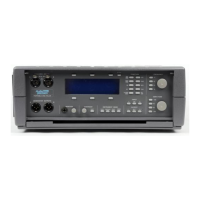
Do you have a question about the Audio Precision Portable One Plus Access and is the answer not in the manual?
| Type | Audio Analyzer |
|---|---|
| Audio Analyzer Type | Portable |
| Input Channels | 2 |
| Output Channels | 2 |
| Analog Generator Outputs | 2 |
| Interface | USB |
| Dynamic Range | 120 dB |
| Power Supply | Internal battery or external power |
| Weight | 2.5 kg |
| Supported Operating Systems | Windows |
| Digital Generator Outputs | AES/SPDIF |
Explains symbols for warnings and identification on equipment panels.
Lists the core measurement capabilities of the audio test instrument.
Instructions on how to remove the front cover and use the tilt bail for positioning.
Defines and differentiates between balanced and unbalanced audio connection types.
Describes how to connect analyzer inputs and generator outputs to external devices.
Explains the function and use of the trigger output connector for external synchronization.
Details the two available monitor outputs for listening to audio signals.
Adjusting display contrast, navigating instrument modes, and panel selection.
Understanding the layout and display modes of instrument panels for measurements and printing.
Managing test setups, using soft keys, and selecting measurement functions.
Controlling generator and analyzer parameters like input/output, frequency, and amplitude.
Setting reference levels, monitoring audio signals, and configuring instrument settings.
Details the instrument's screen saver feature to conserve backlight life.
General introduction to the generator capabilities and output configurations.
Explanation of the front panel controls for managing generator functions.
How generator output impedance affects measurements and calculations.
Introduction to the analyzer's measurement functions and capabilities.
Selecting input channels and measurement functions for the analyzer.
Measuring signal amplitude, noise, and level with filter and unit options.
Measuring distortion, SINAD, and phase shift between signals.
Measuring IMD, Wow/Flutter, Ratio, and Crosstalk.
Monitoring AC mains, measuring input impedance, and auxiliary signal specs.
Using bargraphs, creating sweep graphs, and performing external sweeps.
Procedures and options for printing instrument data, graphs, and screen dumps.
Storing and retrieving instrument configurations and test data.
Procedures for printing previously saved test setup data.
Details the various units available for measuring amplitude.
Explains the difference and correct usage of dBm vs. dBu units.
Describes units for power (Watts, dBm) and frequency (Hz, %).
Defines the unit for phase measurement (degrees).
Testing frequency response of audio equipment and audio transmission links.
Guide for aligning and testing analog tape recorders using various functions.
Methods for testing CD players using sweep tones and THD+N measurements.
A simplified overview of the instrument's internal circuitry.
Diagrams illustrating generator output and analyzer input circuitry.
Examples and wiring for balanced, unbalanced, and stereo audio cable connections.
Procedures for checking and changing the instrument's input voltage setting.
Verifying fuse block orientation and checking fuse values.
Technical specifications for sine wave, IMD signals, and output characteristics.
Detailed specs for analyzer inputs, level/frequency meters, phase, noise, filters, and detection.
Overall power, temperature, humidity, altitude, EMC, safety, dimensions, and weight.
